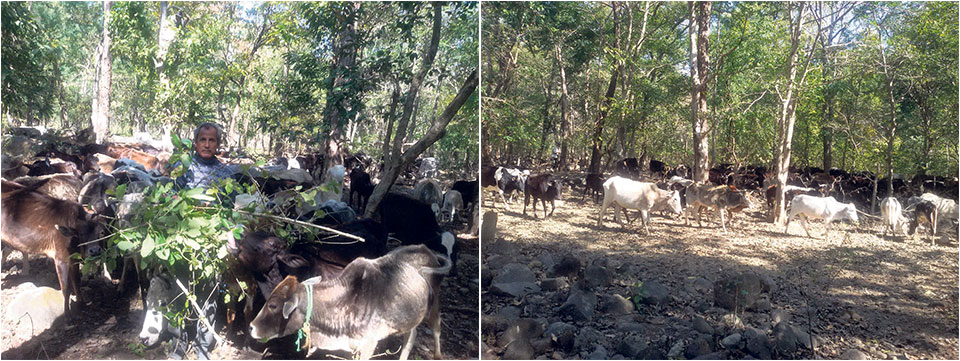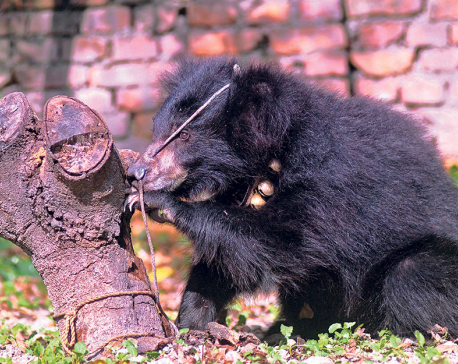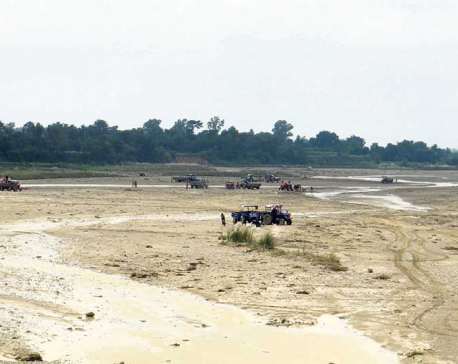
OR
Ghodaghodi Municipality struggling to manage stray cattle
Published On: February 4, 2019 10:07 AM NPT By: DILBAHADUR CHHATYAL/PUSHPARAJ JOSHI

KAILALI, Feb 4: Six months ago Ghodaghodhi Municipality came up with a plan to manage stray cattle. As part of the plan, it built a shed for stray cattle in a national forest located at the base of Chure range. Around 2000 stray cattle including cows and calves were collected in August. Since it was challenging for the authority to keep so many of cattle, the municipality erected three more sheds at Sisneghri, Chyurepani and Kalibhawar areas. It also hired 19 shepherds to look after the cattle by paying them Rs 1,200 per month.
At Sisneghari 1000 cows, at Cheurepani 400 cows and at Kalibhawar 600 cows were kept and reared. Shepherds of Sisneghari took the cows for grazing at Kuntikothai area, which is one hour walk. The shepherds could not control the herd and some of the cattle escaped their sight and went back to villages from where they were collected. They returned to the sheds with whatever the number of the cows were left. When the cattle were taken to jungle the next day, the sheperds again lost control of some more cattle.
Some of the cattle were infected with diseases. While some of these infected cattle and calves recovered from the illness, some became a victim of it. Because of the illness and the inability of the shepherds to bring home all the cattle, only a few of the cattle of the initial 1000 are left now at the sheds managed by the municipality.
“It is very tough to control stray cattle. Managing stray cattle is a very difficult job, it’s very difficult to understand how they react and behave, “ said one of the shepherds, Bhoj Bahadur Chaudhari. “We took them to the jungle for grazing but it became impossible for us to control them,” he added.
According to Chaudhari, the cattle did not pay heed to any of their instructions. They would just go here and there and then disappear, he said adding that some these cattle eventually returned to the shed on their own.
“Some of the cattle who had initially had escaped, returned to the shed later on. However, some are still missing,” said Chaudhari.
He stated that some of these cattle headed to Sukhad market, some others to Ramshikharjha and yet some went to Mohnyal Rural Municipality. “Though we later learned where they headed too, we could not get them back and thus, the number of cattle in the shed decreased,” he said. “Some died in lack of medical attention, some died to cold, pests, diseases,” he added.
According to another shepherd, Khusiram Chaudhari, sensing the moods or understanding the behavior of the stray cattle was the most challenging part. As it was not easy to figure out what the cows were up to, they could not manage them well, he said.
“Had they grown up with humans at home, their behavior would be different, but they had difficult ‘behavior’,” said Khushiram. “Some old cattle died due to illnesses, and some were lost in the jungle.” According to Khushiram, around 30 calves have also died.
The biggest crisis for those cattle is the lack of grass in the jungle nowadays. Sisneghari forest had vast pastures in the past but nowadays most of the pasture is no more due to the expansion of human settlement in the surrounding area.
“As they was no grass in the jungle, they came down to the lower land from the hills and during this journey some of the cattle wandered off,” noted a local of Sisneghari Man Bahadur Budha. “There is no grass for the cattle in jungle nowadays these days.” He also put the blame on shepherds for the loss of the cows. ‘Had they been more careful and vigilant, so many cattle would not die or disappear.’
Meanwhile, Police Inspector Yaksharaj Joshi said that cold was one of the reasons behind the death of some of the cattle. “Some cattle have died due to the cold, some fell ill,” he said.
Joshi stated that gathering stray cattle alone cannot be the solution, if there is no proper arrangement to rear them. “As there is lack of fodder and grass in the jungle for them, they wander around,” he said.
Joshi informed that 70 cows have died so far at Kalibhawar and Chyurepani shred. “They are rumors that many cattle have died at these sheds but let me clarify that the number of cattle dead is70,” he said.
Mamata Prasad Chaudhari, Mayor of Ghodaghodi Municipality also endorsed the number. “The death toll is 70,” Mamata said.
The issue had caught headlines of local media after some NGOs claimed that thousands of cows have died in these sheds. “The cows have also died due to plastic consumption. They are eating plastics,” Mamata clarified.
You May Like This

Wild bear electrocuted in Chure range
UDAYAPUR, Jan 5: A bear was electrocuted on Monday in a forest in the Chure range of Katari Municipality in... Read More...

Former prez Yadav concerned over Chure destruction
DANG, Jan 12: Concerned about the rampant excavation in the Chure range, former president Dr Ram Baran Yadav has urged... Read More...

Local governments allowing mining in Chure to generate income
LAHAN, Nov 1: During the last local and provincial elections, one of the promises that almost all political parties and leaders... Read More...




Just In
- Nepalgunj ICP handed over to Nepal, to come into operation from May 8
- Nepal to gift two elephants to Qatar during Emir's state visit
- NUP Chair Shrestha: Resham Chaudhary, convicted in Tikapur murder case, ineligible for party membership
- Dr Ram Kantha Makaju Shrestha: A visionary leader transforming healthcare in Nepal
- Let us present practical projects, not 'wish list': PM Dahal
- President Paudel requests Emir of Qatar to help secure release of Bipin Joshi held hostage by Hamas
- Emir of Qatar and President Paudel hold discussions at Sheetal Niwas
- Devi Khadka: The champion of sexual violence victims



_20240423174443.jpg)











Leave A Comment